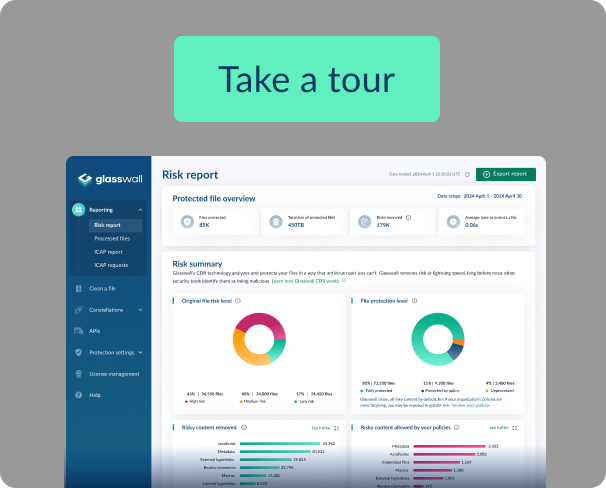What is Content Disarm and Reconstruction (CDR)?
Content Disarm and Reconstruction (CDR) is an advanced cybersecurity technology designed to neutralize threats, such as malware and ransomware, within files.
CDR works by disassembling files (documents, images, etc.) and removing any potentially malicious elements. Advanced CDR solutions, such as Glasswall CDR technology, are able to retain a document’s original functionality and appearance – providing seamless protection to the end user.
The advantages of CDR
Content Disarm and Reconstruction plays a crucial role in enhancing an organization’s cybersecurity strategy. Here are 4 reasons why CDR is considered one of the most effective file protection solutions:

1. CDR removes threats from files
CDR is a Zero Trust data filter that rebuilds files and documents into a safe, clean standard, free from the risks of malware. CDR prevents malicious files from entering a network and is used for secure file transfer across trust boundaries.

2. CDR is more secure than antivirus and sandboxing
Unlike detection-based solutions, CDR doesn’t try to identify malicious code – it simply removes the ability for it to exist altogether. This Zero Trust approach disarms often overlooked advanced persistent threats, such as zero-day malware, high-risk active code and anomalies within a file’s structure.

3. CDR retains file functionality
Many conventional data filters flatten files (turn them into images) for use in high risk environments. Files cleaned by CDR are visually identical and fully functional, meaning you get your report – not a pancake.

4. CDR helps teams manage risk
CDR offers organizations comprehensive analysis of the threats within files, empowering security teams to remove or manage high-risk content according to their risk appetite.
CDR vs other technologies
While our recommendation is that CDR should be used as one component of a wider cybersecurity strategy, it is helpful to understand the significant advantages CDR has over other file protection technologies.
Glasswall CDR

- Protects against unknown (zero-day) threats
- Files are secured instantly with usability maintained
- Doesn’t require an internet connection or updates
Sandboxing

- Can be evaded by malware with delayed detonation
- Files are held or quarantined
- Needs updating to protect against the newest threats
File flattening

- Vulnerable to image steganography attack
- Files are turned into images at the cost of functionality
- Often antiquated systems require updating
How our CDR works
Glasswall CDR employs our patented 4-step approach to protect government agencies and organizations against file-based threats. Unlike other cybersecurity solutions, we don’t try to identify the malicious code – we simply remove the ability for it to exist in the file altogether.

1. Inspect
Breaks down the file into its constituent components. Validates the file’s structure against its specification

2. Rebuild
Unknown and invalid file structures are repaired in-line with the file’s specification

3. Clean
Removes high-risk file structures that contain active content, based on configurable policy

4. Deliver
Semantic checks ensure the file’s integrity. The safe and fully functional file is now ready to use









.avif)

